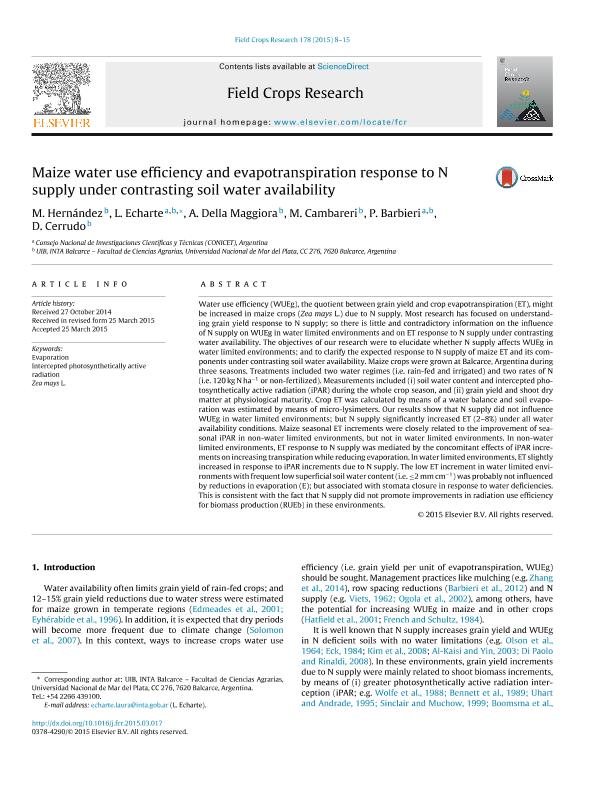Artículo
Maize water use efficiency and evapotranspiration response to N supply under contrasting soil water availability
Hernandez, Mariano Daniel ; Echarte, Laura
; Echarte, Laura ; Della Maggiora, Aída Inés; Cambareri, Matías Alejandro; Barbieri, Pablo Andres
; Della Maggiora, Aída Inés; Cambareri, Matías Alejandro; Barbieri, Pablo Andres ; Cerrudo, Diego
; Cerrudo, Diego
 ; Echarte, Laura
; Echarte, Laura ; Della Maggiora, Aída Inés; Cambareri, Matías Alejandro; Barbieri, Pablo Andres
; Della Maggiora, Aída Inés; Cambareri, Matías Alejandro; Barbieri, Pablo Andres ; Cerrudo, Diego
; Cerrudo, Diego
Fecha de publicación:
07/2015
Editorial:
Elsevier Science
Revista:
Field Crops Research
ISSN:
0378-4290
Idioma:
Inglés
Tipo de recurso:
Artículo publicado
Clasificación temática:
Resumen
Water use efficiency (WUEg), the quotient between grain yield and crop evapotranspiration (ET), might be increased in maize crops (Zea mays L.) due to N supply. Most research has focused on understanding grain yield response to N supply; so there is little and contradictory information on the influence of N supply on WUEg in water limited environments and on ET response to N supply under contrasting water availability. The objectives of our research were to elucidate whether N supply affects WUEg in water limited environments; and to clarify the expected response to N supply of maize ET and its components under contrasting soil water availability. Maize crops were grown at Balcarce, Argentina during three seasons. Treatments included two water regimes (i.e. rain-fed and irrigated) and two rates of N (i.e. 120kgNha-1 or non-fertilized). Measurements included (i) soil water content and intercepted photosynthetically active radiation (iPAR) during the whole crop season, and (ii) grain yield and shoot dry matter at physiological maturity. Crop ET was calculated by means of a water balance and soil evaporation was estimated by means of micro-lysimeters. Our results show that N supply did not influence WUEg in water limited environments; but N supply significantly increased ET (2-8%) under all water availability conditions. Maize seasonal ET increments were closely related to the improvement of seasonal iPAR in non-water limited environments, but not in water limited environments. In non-water limited environments, ET response to N supply was mediated by the concomitant effects of iPAR increments on increasing transpiration while reducing evaporation. In water limited environments, ET slightly increased in response to iPAR increments due to N supply. The low ET increment in water limited environments with frequent low superficial soil water content (i.e. ≤2mmcm-1) was probably not influenced by reductions in evaporation (E); but associated with stomata closure in response to water deficiencies. This is consistent with the fact that N supply did not promote improvements in radiation use efficiency for biomass production (RUEb) in these environments.
Palabras clave:
EVAPORATION
,
INTERCEPTED PHOTOSYNTHETICALLY ACTIVE RADIATION
,
ZEA MAYS L
Archivos asociados
Licencia
Identificadores
Colecciones
Articulos(CCT - MAR DEL PLATA)
Articulos de CTRO.CIENTIFICO TECNOL.CONICET - MAR DEL PLATA
Articulos de CTRO.CIENTIFICO TECNOL.CONICET - MAR DEL PLATA
Citación
Hernandez, Mariano Daniel; Echarte, Laura; Della Maggiora, Aída Inés; Cambareri, Matías Alejandro; Barbieri, Pablo Andres; et al.; Maize water use efficiency and evapotranspiration response to N supply under contrasting soil water availability; Elsevier Science; Field Crops Research; 178; 7-2015; 8-15
Compartir
Altmétricas



